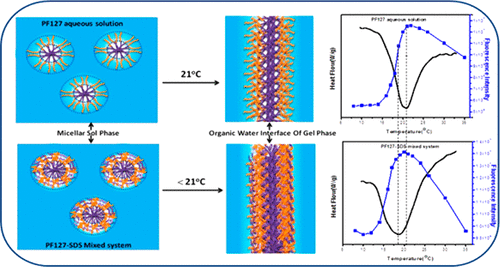当前位置:
X-MOL 学术
›
J. Phys. Chem. B
›
论文详情
Our official English website, www.x-mol.net, welcomes your
feedback! (Note: you will need to create a separate account there.)
Molecular Level Understanding of Sodium Dodecyl Sulfate (SDS) Induced Sol–Gel Transition of Pluronic F127 Using Fisetin as a Fluorescent Molecular Probe
The Journal of Physical Chemistry B ( IF 2.8 ) Pub Date : 2017-12-22 00:00:00 , DOI: 10.1021/acs.jpcb.7b10170
Jhili Mishra 1 , Jitendriya Swain 1 , Ashok Kumar Mishra 1
The Journal of Physical Chemistry B ( IF 2.8 ) Pub Date : 2017-12-22 00:00:00 , DOI: 10.1021/acs.jpcb.7b10170
Jhili Mishra 1 , Jitendriya Swain 1 , Ashok Kumar Mishra 1
Affiliation

|
The thermoreversible sol–gel transition of pluronic F127 is markedly altered even with addition of submicellar concentration of sodium dodecyl sulfate (SDS) surfactant. Multiple fluorescence parameters like fluorescence intensity, fluorescence anisotropy and fluorescence lifetime of both the prototropic forms (anion (A–*) and phototautomer FT*) of the photoprototropic fluorescent probe fisetin has been efficiently used to understand the molecular level properties like polarity and microviscosity of the PF127–SDS system as a function of temperature. The SDS-induced increase in the interfacial hydrophobicity level is seen to affect the sol–gel phase transition of PF127 (21–18 °C). The ET(30) polarity parameter value of anionic emission of fisetin suggests that there is a considerable decrease in the polarity of the PF127 medium with increase in temperature and with the addition of SDS. The microviscosity progressively increases from ∼5 mPa s (sol state, 10 °C) to ∼22.01 mPa s (gel state 35 °C) in aqueous solution of PF127. The variation in microviscosity with addition of SDS in PF127–SDS mixed system is significant in sol phase whereas in gel phase this variation is significantly less. Temperature dependent fluorescence lifetime of FT* indicates that there is heterogeneity in distribution of fisetin molecules at different domains of PF127. This work also show-cases the sensitivity of fisetin toward change in polarity and change in sol–gel transition temperature of copolymer PF127 with variation in temperature (both forward and reverse directions) and SDS.
中文翻译:

以菲塞汀为荧光分子探针的十二烷基硫酸钠(SDS)诱导的Pluronic F127的溶胶-凝胶转变的分子水平理解
即使加入了低于胶束浓度的十二烷基硫酸钠(SDS)表面活性剂,普卢尼克F127的热可逆溶胶-凝胶转变也会显着改变。质子荧光探针fisetin的质子形式(阴离子(A – *)和互变异构体FT *)的多个荧光参数(如荧光强度,荧光各向异性和荧光寿命)已被有效地用于理解分子水平特性,例如极性和微粘度。 PF127–SDS系统是温度的函数。SDS诱导的界面疏水性水平升高会影响PF127(21–18°C)的溶胶-凝胶相变。该Ë Ť(30)非瑟酮阴离子发射的极性参数值表明,随着温度的升高和SDS的添加,PF127介质的极性显着降低。在PF127的水溶液中,微粘度从〜5 mPa s(溶胶状态,10°C)逐渐增加到〜22.01 mPa s(凝胶状态35°C)。在溶胶相中,PF127-SDS混合体系中添加SDS引起的微粘度变化显着,而在凝胶相中,这种变化显着减小。FT *的温度依赖性荧光寿命表明,在PF127的不同域中,非瑟酮分子的分布存在异质性。
更新日期:2017-12-22
中文翻译:

以菲塞汀为荧光分子探针的十二烷基硫酸钠(SDS)诱导的Pluronic F127的溶胶-凝胶转变的分子水平理解
即使加入了低于胶束浓度的十二烷基硫酸钠(SDS)表面活性剂,普卢尼克F127的热可逆溶胶-凝胶转变也会显着改变。质子荧光探针fisetin的质子形式(阴离子(A – *)和互变异构体FT *)的多个荧光参数(如荧光强度,荧光各向异性和荧光寿命)已被有效地用于理解分子水平特性,例如极性和微粘度。 PF127–SDS系统是温度的函数。SDS诱导的界面疏水性水平升高会影响PF127(21–18°C)的溶胶-凝胶相变。该Ë Ť(30)非瑟酮阴离子发射的极性参数值表明,随着温度的升高和SDS的添加,PF127介质的极性显着降低。在PF127的水溶液中,微粘度从〜5 mPa s(溶胶状态,10°C)逐渐增加到〜22.01 mPa s(凝胶状态35°C)。在溶胶相中,PF127-SDS混合体系中添加SDS引起的微粘度变化显着,而在凝胶相中,这种变化显着减小。FT *的温度依赖性荧光寿命表明,在PF127的不同域中,非瑟酮分子的分布存在异质性。































 京公网安备 11010802027423号
京公网安备 11010802027423号